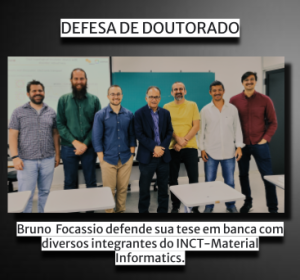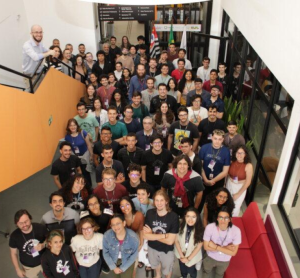2023
Barcelos, Ingrid D.; de Oliveira, Raphaela; Schleder, Gabriel R.; Matos, Matheus J. S.; Longuinhos, Raphael; Ribeiro-Soares, Jenaina; Barboza, Ana Paula M.; Prado, Mariana C.; Pinto, Elisângela S.; Gobato, Yara Galvão; Chacham, Hélio; Neves, Bernardo R. A.; Cadore, Alisson R.
Phyllosilicates as earth-abundant layered materials for electronics and optoelectronics: Prospects and challenges in their ultrathin limit Journal Article
Em: vol. 134, não 9, 2023, ISSN: 1089-7550.
@article{Barcelos2023,
title = {Phyllosilicates as earth-abundant layered materials for electronics and optoelectronics: Prospects and challenges in their ultrathin limit},
author = {Ingrid D. Barcelos and Raphaela de Oliveira and Gabriel R. Schleder and Matheus J. S. Matos and Raphael Longuinhos and Jenaina Ribeiro-Soares and Ana Paula M. Barboza and Mariana C. Prado and Elisângela S. Pinto and Yara Galvão Gobato and Hélio Chacham and Bernardo R. A. Neves and Alisson R. Cadore},
doi = {10.1063/5.0161736},
issn = {1089-7550},
year = {2023},
date = {2023-09-07},
volume = {134},
number = {9},
publisher = {AIP Publishing},
abstract = {Phyllosilicate minerals are an emerging class of naturally occurring layered insulators with large bandgap energy that have gained attention from the scientific community. This class of lamellar materials has been recently explored at the ultrathin two-dimensional level due to their specific mechanical, electrical, magnetic, and optoelectronic properties, which are crucial for engineering novel devices (including heterostructures). Due to these properties, phyllosilicate minerals can be considered promising low-cost nanomaterials for future applications. In this Perspective article, we will present relevant features of these materials for their use in potential 2D-based electronic and optoelectronic applications, also discussing some of the major challenges in working with them.},
keywords = {General Physics and Astronomy},
pubstate = {published},
tppubtype = {article}
}
Phyllosilicate minerals are an emerging class of naturally occurring layered insulators with large bandgap energy that have gained attention from the scientific community. This class of lamellar materials has been recently explored at the ultrathin two-dimensional level due to their specific mechanical, electrical, magnetic, and optoelectronic properties, which are crucial for engineering novel devices (including heterostructures). Due to these properties, phyllosilicate minerals can be considered promising low-cost nanomaterials for future applications. In this Perspective article, we will present relevant features of these materials for their use in potential 2D-based electronic and optoelectronic applications, also discussing some of the major challenges in working with them.
Claro, Pedro I. C.; Borges, Egon P. B. S.; Schleder, Gabriel R.; Archilha, Nathaly L.; Pinto, Allan; Carvalho, Murilo; Driemeier, Carlos E.; Fazzio, Adalberto; Gouveia, Rubia F.
From micro- to nano- and time-resolved x-ray computed tomography: Bio-based applications, synchrotron capabilities, and data-driven processing Journal Article
Em: vol. 10, não 2, 2023, ISSN: 1931-9401.
@article{Claro2023,
title = {From micro- to nano- and time-resolved x-ray computed tomography: Bio-based applications, synchrotron capabilities, and data-driven processing},
author = {Pedro I. C. Claro and Egon P. B. S. Borges and Gabriel R. Schleder and Nathaly L. Archilha and Allan Pinto and Murilo Carvalho and Carlos E. Driemeier and Adalberto Fazzio and Rubia F. Gouveia},
doi = {10.1063/5.0129324},
issn = {1931-9401},
year = {2023},
date = {2023-06-01},
volume = {10},
number = {2},
publisher = {AIP Publishing},
abstract = {X-ray computed microtomography (μCT) is an innovative and nondestructive versatile technique that has been used extensively to investigate bio-based systems in multiple application areas. Emerging progress in this field has brought countless studies using μCT characterization, revealing three-dimensional (3D) material structures and quantifying features such as defects, pores, secondary phases, filler dispersions, and internal interfaces. Recently, x-ray computed tomography (CT) beamlines coupled to synchrotron light sources have also enabled computed nanotomography (nCT) and four-dimensional (4D) characterization, allowing in situ, in vivo, and in operando characterization from the micro- to nanostructure. This increase in temporal and spatial resolutions produces a deluge of data to be processed, including real-time processing, to provide feedback during experiments. To overcome this issue, deep learning techniques have risen as a powerful tool that permits the automation of large amounts of data processing, availing the maximum beamline capabilities. In this context, this review outlines applications, synchrotron capabilities, and data-driven processing, focusing on the urgency of combining computational tools with experimental data. We bring a recent overview on this topic to researchers and professionals working not only in this and related areas but also to readers starting their contact with x-ray CT techniques and deep learning.},
keywords = {General Physics and Astronomy},
pubstate = {published},
tppubtype = {article}
}
X-ray computed microtomography (μCT) is an innovative and nondestructive versatile technique that has been used extensively to investigate bio-based systems in multiple application areas. Emerging progress in this field has brought countless studies using μCT characterization, revealing three-dimensional (3D) material structures and quantifying features such as defects, pores, secondary phases, filler dispersions, and internal interfaces. Recently, x-ray computed tomography (CT) beamlines coupled to synchrotron light sources have also enabled computed nanotomography (nCT) and four-dimensional (4D) characterization, allowing in situ, in vivo, and in operando characterization from the micro- to nanostructure. This increase in temporal and spatial resolutions produces a deluge of data to be processed, including real-time processing, to provide feedback during experiments. To overcome this issue, deep learning techniques have risen as a powerful tool that permits the automation of large amounts of data processing, availing the maximum beamline capabilities. In this context, this review outlines applications, synchrotron capabilities, and data-driven processing, focusing on the urgency of combining computational tools with experimental data. We bring a recent overview on this topic to researchers and professionals working not only in this and related areas but also to readers starting their contact with x-ray CT techniques and deep learning.






